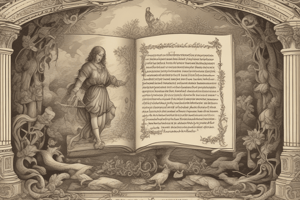Podcast
Questions and Answers
What is the structure of a Shakespearean sonnet?
What is the structure of a Shakespearean sonnet?
Who published the 'Sonnets by William Shakespeare: Never Printed Before' in 1609?
Who published the 'Sonnets by William Shakespeare: Never Printed Before' in 1609?
What is the role of the quatrain in a Shakespearean sonnet?
What is the role of the quatrain in a Shakespearean sonnet?
What was the subject range of Shakespeare's sonnets?
What was the subject range of Shakespeare's sonnets?
Signup and view all the answers
What impact did Shakespeare's use of the sonnet form have?
What impact did Shakespeare's use of the sonnet form have?
Signup and view all the answers
What did Leon Battista Alberti advocate for in architectural theory?
What did Leon Battista Alberti advocate for in architectural theory?
Signup and view all the answers
What characterized the Mannerism art movement as a reaction to the High Renaissance?
What characterized the Mannerism art movement as a reaction to the High Renaissance?
Signup and view all the answers
What was a significant feature of Baroque architecture?
What was a significant feature of Baroque architecture?
Signup and view all the answers
How did the use of perspective drawing impact European culture?
How did the use of perspective drawing impact European culture?
Signup and view all the answers
What role did classical architectural elements play in urban planning?
What role did classical architectural elements play in urban planning?
Signup and view all the answers
Study Notes
- John Green, in his Crash Course English literature class, engages with the audience comparing a day to a summer day and expressing admiration for their looks.
- Sonnets by William Shakespeare were published in 1609 and are composed of four to fifteen lines.
- The Shakespearean sonnet follows a specific rhyme scheme and structure - iambic pentameter - with each line consisting of ten syllables.
- The sonnet form is named after its originator, although 'Shakespeare' did not originally name it as such, but instead used it effectively.
- The sonnet structure consists of the quatrain (four lines) and the couplet (two lines), with the quatrain introducing the problem or question, and the couplet offering the solution or resolution.
- Sonnets were popular in the late sixteenth century, and poets like Ben Jonson and Thomas Thorpe published collections of Shakespeare's sonnets.
- In 1609, Thomas Thorpe published "Sonnets by William Shakespeare: Never Printed Before," dedicating it to the unidentified "Mr. W.H."
- The publication of Shakespeare's sonnets remained a topic of debate, with some questioning whether Shakespeare himself wrote them or if they were ghost-written.
- Some sonnets contain vivid descriptions of emotions and relationships, while others explore more abstract themes.
- The subject of Shakespeare's sonnets ranges from love and beauty to aging, mortality, and the passage of time.
- Sonnets were a popular poetic form in the late Elizabethan period, and poets often experimented with various rhyme schemes and structures to create unique works.
- Shakespeare's use of the sonnet form allowed him to express complex emotions and ideas within a compact and elegant form.- The text discusses various aspects of architectural styles and their impact on society.
- The Renaissance period marked a significant shift towards humanism in art and architecture.
- Leon Battista Alberti, a prominent figure of the Renaissance, is known for his contribution to architectural theory.
- He advocated for the use of geometry and proportion in designing buildings.
- Alberti's ideas influenced the development of perspectival drawing, which helped architects create realistic representations of their designs.
- The High Renaissance saw the emergence of monumental architecture, such as St. Peter's Basilica in Rome.
- Mannerism was a reaction to the grandiosity of the High Renaissance, characterized by an emphasis on individuality and complexity.
- The Baroque period brought about ornate and dramatic architecture, often used to convey power and opulence.
- The text also touches upon the influence of architectural styles on societal norms and values.
- For example, the development of perspective drawing allowed for the creation of illusionistic spaces, which contributed to the rise of the concept of depth in European culture.
- Additionally, the grandeur of Baroque architecture reflected the growing power and wealth of European monarchies.
- The text also discusses the role of architecture in shaping the built environment and influencing urban planning.
- For instance, the use of classical architectural elements in the design of public buildings helped establish a sense of order and stability in cities.
- Overall, the text provides a historical overview of the development of Western architectural styles and their impact on society.
Studying That Suits You
Use AI to generate personalized quizzes and flashcards to suit your learning preferences.
Description
Explore the themes, structure, and publication history of Shakespeare's sonnets, as well as the impact of Renaissance architectural styles on society and urban planning.




